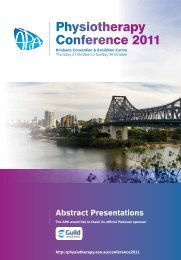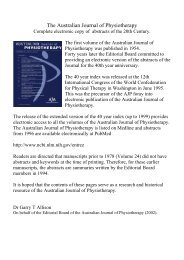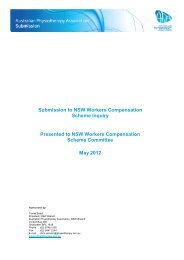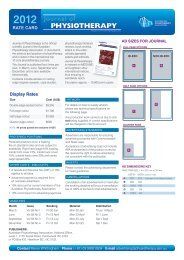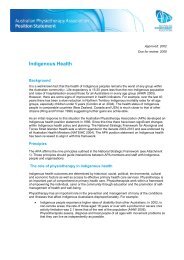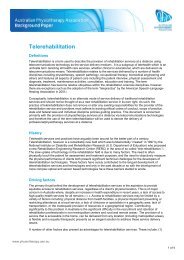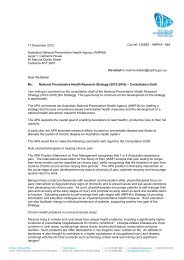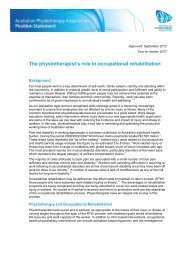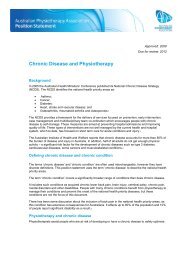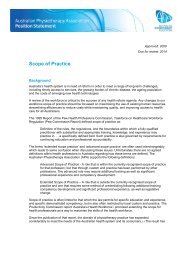2009 APA Conference Week Abstracts - Australian Physiotherapy ...
2009 APA Conference Week Abstracts - Australian Physiotherapy ...
2009 APA Conference Week Abstracts - Australian Physiotherapy ...
Create successful ePaper yourself
Turn your PDF publications into a flip-book with our unique Google optimized e-Paper software.
Cardiorespiratory <strong>Physiotherapy</strong> Australia<br />
secondary outcome measures were resting and post-test<br />
heart rate, blood pressure and oxygen saturation, peak<br />
heart rate, and perceived intensity of exertion. A training<br />
effect was observed, in that patients walked further on the<br />
second walk test (p < 0.001). Peak heart rate (p = 0.002)<br />
and perceived intensity of exertion (p = 0.003) were also<br />
higher for the second walk test. The mean improvement in<br />
distance (18 m) from first to second test was small relative<br />
to total six-minute walk distance (test one: 471 m, test two:<br />
489 m). It is recommended that a training effect be taken<br />
into consideration when comparing pre-operative to postoperative<br />
six-minute walk test performance in patients<br />
undergoing coronary artery bypass graft surgery.<br />
A randomised controlled trial of staircase recruitment<br />
manoeuvres, high PEEP and low airway pressure as a<br />
bundle of protective ventilation<br />
Hodgson CL, 1,2 Nichol A, 1,2 Tuxen DV, 1,2 Bailey M, 1,2<br />
Holland AE, 1,3 Keating J, 2 Pilcher D, 1 Davies A, 1,2<br />
Westbrook A, 2 Hilton A, 1 Cooper DJ 1,2<br />
1<br />
The Alfred Hospital, Melbourne, 2 Monash University, Melbourne, 3 La<br />
Trobe University, Melbourne<br />
The aim of this study was to examine the effectiveness of an<br />
‘optimal’ ventilatory strategy including staircase recruitment<br />
manoeuvres compared to current best practice in patients<br />
with acute respiratory distress syndrome (ARDS). The<br />
‘optimal’ ventilator strategy consisted of a novel open lung<br />
low airway pressure approach (Permissive Hypercapnia<br />
and Alveolar Recruitment with Limited Airway Pressures:<br />
PHARLAP ACTRN12607000465459) compared to the<br />
current ARDS net low tidal volume strategy. In this report,<br />
we describe the oxygenation results of our first interim<br />
analysis. Fifteen subjects (ten males) with ARDS and a<br />
mean age of 57.2 ± 15.3 years and baseline PaO2/FiO2 157<br />
± 54 were randomly allocated into experimental PHARLAP<br />
ventilation (n = 8) or control ventilation (n = 7). Outcomes<br />
were gas exchange and lung compliance at 1, 3, 6 and 24<br />
hours. At 24 hours PHARLAP ventilation improved PaO2/<br />
FiO2 ratio (PHARLAP 223.06 ± 25.46, Control 130.9 ±<br />
13.06, p = 0.009) and lung compliance (PHARLAP 43.62<br />
± 3.85, Control 27.7 ± 2.33, p = 0.001). These preliminary<br />
results suggest that a package of ventilation including<br />
staircase recruitment manoeuvres and high PEEP are well<br />
tolerated and may be effective to improve oxygenation and<br />
lung compliance in patients with acute respiratory distress<br />
syndrome.<br />
The effects of a thoracic mobilisation exercise program<br />
following open heart surgery: a randomised<br />
controlled pilot study<br />
Hoggins TR, 1 Denehy L, 2 Tully EA, 2 El-Ansary D 2<br />
1<br />
Monash Medical Centre, Melbourne 2 The University of Melbourne,<br />
Melbourne<br />
The aims of this study were to investigate any trends in<br />
differences for thoracic and shoulder range of movement,<br />
pain and function, between participants provided with a<br />
thoracic mobilisation exercise program and those receiving<br />
standard care after open heart surgery. A single-blinded<br />
randomised controlled pilot study was carried out in a tertiary<br />
public hospital in Melbourne. Thirty-eight participants who<br />
underwent open heart surgery were randomly allocated<br />
using concealed allocation to a treatment (n = 23), or a<br />
control (n = 15) group. In addition to standard post-operative<br />
physiotherapy care, treatment group participants received an<br />
individualised, progressive thoracic mobilisation exercise<br />
program on discharge from the acute hospital. Control group<br />
participants received no thoracic mobilisation exercises.<br />
Baseline pre-operative outcome measures of shoulder and<br />
thoracic range of movement, pain, function and health<br />
related quality of life were repeated post-operatively prior<br />
to discharge, at 4 weeks and 3 months post-operatively.<br />
Reliability of measures of range of movement using ImageJ<br />
was established prior to use. At the conclusion of the followup<br />
period, participants completed a global rating of change.<br />
Treatment group participants reported less sternal pain at 4<br />
weeks post discharge (p = 0.029) and greater improvements<br />
on the global rating of change assessment (p = 0.04). There<br />
were no significant differences between groups for shoulder<br />
or thoracic range of movement, function, or health related<br />
quality of life. The role of thoracic mobilisation exercises<br />
following open heart surgery in reducing sternal pain<br />
warrants further investigation.<br />
The functional difficulties questionnaire: a new tool<br />
for measuring physical function in an open heart<br />
surgery population<br />
Hoggins TR, 1 Denehy L, 2 Tully EA, 2 El-Ansary D 2<br />
1<br />
Monash Medical Centre, Melbourne 2 The University of Melbourne,<br />
Melbourne<br />
A functional questionnaire suitable for a population following<br />
open heart surgery which addresses the thoracic region and<br />
has been validated currently does not exist. A new tool, the<br />
functional difficulties questionnaire, was developed for this<br />
purpose and comprises 13 functional tasks that are likely<br />
to cause difficulty following open heart surgery, as well<br />
as being tasks necessary in everyday life. The respondent<br />
marks the degree of difficulty they experience for each<br />
component task on a 10 cm visual analogue scale (VAS).<br />
Individual VAS scores are aggregated to form a total out of<br />
130, with higher scores representing greater difficulty. The<br />
aims of this study were to provide preliminary evidence as<br />
to the functional difficulties questionnaire’s validity and<br />
sensitivity to change. Thirty-eight participants undergoing<br />
open heart surgery completed the questionnaire preoperatively,<br />
post-operatively, 4 weeks post-operatively and<br />
3 months post-operatively. The questionnaire showed good<br />
internal consistency, with a Cronbach alpha coefficient of<br />
0.971. Results showed a significant increase in functional<br />
difficulties questionnaire scores from pre-operatively to<br />
post-operatively (p < 0.001) and a significant decrease in<br />
scores from post-operatively to 4r weeks post-operatively<br />
(p < 0.001) and from 4 weeks post-operatively to 3 months<br />
post-operatively (p = 0.006). There was a moderate to good<br />
correlation between the questionnaire’s scores and sternal<br />
pain (rho = 0.60, p < 0.001), shoulder pain (rho = 0.51, p<br />
= 0.001) and total pain (rho = 0.69, p < 0.001). Further<br />
investigation of the tool, particularly with regards to test<br />
re-test reliability, is required.<br />
The e-AJP Vol 55: 4, Supplement 9



